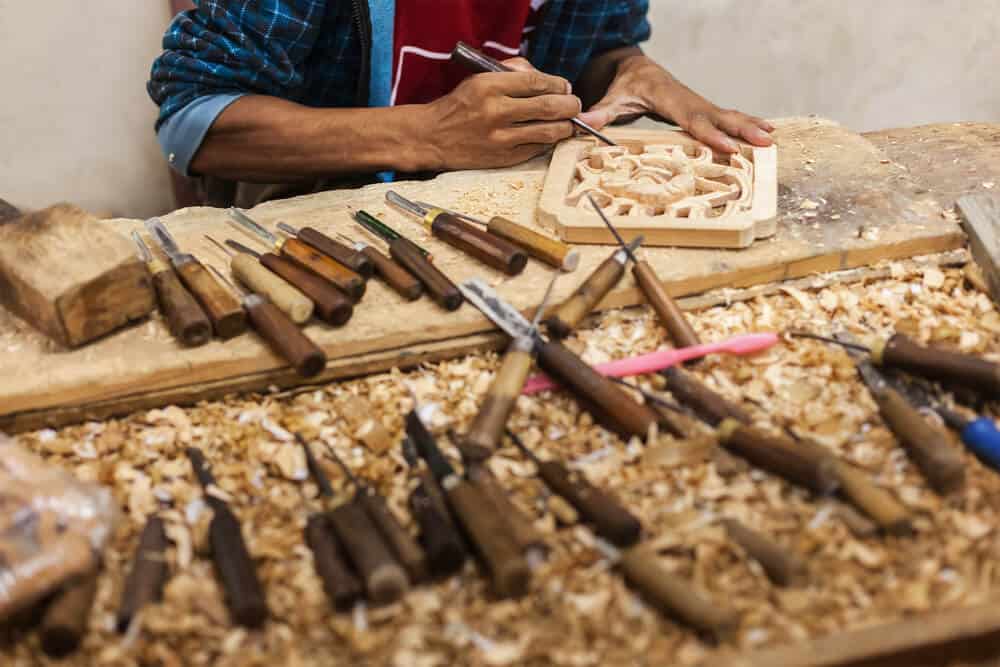Is Crabapple Wood Good for Anything? (9 Quick Facts)

Crabapple trees are members of the Rosaceae family. This family also includes notable fruits such as pears, roses, plums, cherries, and peaches. Crabapples have been around since Roman times.
People used them primarily for cooking until the 1700s. After that, people began to love them for their ornamental qualities in Europe and North America. So, as exciting as crabapple trees are, how good is their wood? Is crabapple wood good for anything?
Previously, people used crabapple wood for construction and manufacturing. Today, it is ideal for cabinetry, furniture, and turned objects. Crabapple wood also makes billiard cues, mallets, and small specialty wood items like carved spoons.
Woodworkers don’t have a hard time working with crabapple wood. The wood is hand tool-friendly, has a straight grain, takes paint and glues well, and turns beautifully. It can also be stained and is an excellent choice for decorative work.
How about I take you through nine quick facts about crabapple wood?
Is Crabapple Softwood or Hardwood?
Crabapple is hardwood like all fruit trees. Crabapple trees grow well in the U.S. Department of Agriculture Hardiness Zone 5 through 9, but artisans may choose to grow them further north.
For instance, crabapple trees do well in Michigan, Wisconsin, Minnesota, and New York.
Crabapple wood is hard but brittle. However, it has a high density of 703 kilograms per cubic meter. That places the wood among high-density hardwood varieties.
What Grain and Color are Crabapple Wood?
The crabapple heartwood ranges in color from a reddish-brown to a darker red or brown. The grain exhibits streaks of lighter or darker color bands.
It has a straight grain, which can also be wild in some areas. The sapwood is a pale cream.
The texture of crabapple wood is fine and uniform. It resembles cherry wood because of its tight and fine pores.
The end grain is diffuse-porous since the vessels are equal in diameter and distributed uniformly throughout the ring.
How Does Crabapple Wood Dry?
I would advise that you dry crabapple wood without seasoning first. Crabapple wood experiences high seasonal movement. If you cut down the crabapple tree and place the log to dry, it can take up to two years till it is completely ready.
Keep the bark on the logs until they are completely dry. This helps keep out insects and prevents crabapple wood from rotting. Treat the wood with a stain preservative to avoid fungal growth.
Can You Burn Crabapple Wood?
Crabapple wood is perfect and safe for burning. It releases a lot of heat and produces a very nice, warm fire.
Crabapple wood burns well indoors. It’s perfect to light in your indoor fireplace or wood stove. Outdoor fireplaces and fire pits at campgrounds also accommodate the use of crabapple wood.
The moisture content should be around 20 percent to 25 percent before burning. Using proper-size pieces will ensure optimum performance of your fireplace or fireplace insert.
Can You Use Crabapple Wood for Smoking?
The most common cooking use of dried crabapple wood is smoking meat, pork, wild birds, and fish. The smoke from the burning crabapple wood adds an apple flavor to the meat.
I like the fruit-like scent because it also helps cover up any odor that might be coming from the meat (natural or otherwise).
How Workable is Crabapple Wood?

Crabapple wood is suitable for making some beautiful furniture pieces and other decorations.
However, sometimes the wood can be too brittle and hard to use for certain applications. It all depends on how the tree was grown, its diseases, and many other factors.
The grain pattern makes crabapple challenging to work with hand tools because it tends to split easily.
While I’d recommend it for small projects such as utensils and toys, you can also use crabapple wood in larger projects such as furniture and musical instruments.
It can be smoothened using sandpaper or a fine file but will remain somewhat rough even after these processes are complete. Because of this, crabapple wood is suitable for making practical items such as bowls, spoons, and toys.
Some woodworkers get creative enough to make jewelry boxes or musical instrument components.
How Hard and Dense is Crabapple Wood?
Crabapple wood has a coarse texture. That aside, the wood has fine pores and has a smooth finish when polished.
Crabapple is hard but brittle, so it is not suitable for heavy construction work. Because of the high density caused by a lot of oil content, it isn’t easy for the machine since it burns easily.
I recommend the use of cutting tools with a long blade. Also, add plenty of water when you cut the wood.
This high density does make the wood resistant to rot and decay when it is appropriately treated.
Is Crabapple Wood Toxic or Allergenic?
Like all wood dust, the dust emitted during the cutting, sanding, and finishing process can cause allergic reactions in some people.
When inhaled regularly and over an extended period, crabapple wood dust may also cause respiratory problems due to the presence of silica.
I’d advise you to wear protective gloves, goggles, and masks when working with this wood. I know it sounds like a cliché, but protective wear protects your eyes and respiratory system.
There are airborne particles or vapors created by sanding or cutting the wood. Be sure to use quality ventilation while working on wood in your home shop or work area.
How Sustainable is Crabapple Wood?
Although crabapple wood is not listed in the CITES Appendices or on the IUCN Red List of Threatened Species, many organizations discourage or forbid the use of wood from rare or endangered species.
Today, we have become more aware of the need to reduce our consumption of wood from non-native forests.
Fortunately, crabapple trees are plentiful in the wild across America and are best-suited for use as a sustainable resource for wood products.
